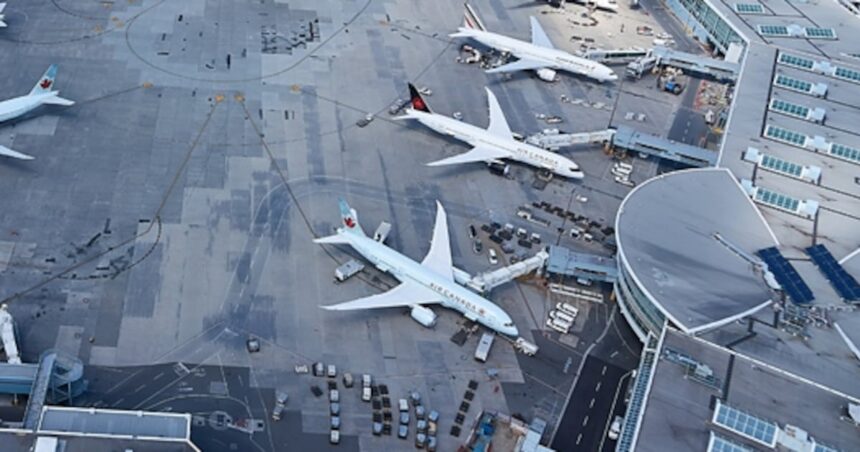Just after midnight on Saturday, passengers aboard Flight AC185 found themselves in a situation most travelers only encounter in pre-flight safety videos: evacuating down emergency slides on the tarmac at Vancouver International Airport.
The Air Canada Boeing 777 bound for Tokyo’s Haneda Airport never left the ground. As the aircraft began its takeoff sequence, the pilots detected what has now been confirmed as an engine fire, bringing the departure to an abrupt halt.
“I heard a loud bang and the plane shook a bit,” passenger Karen Fujimoto told me during a phone interview from her Vancouver hotel room. “The cabin lights flickered, and then the captain’s voice came on saying we needed to stop immediately.”
Fujimoto, visiting family in Tokyo after attending a conference in Vancouver, described the moments that followed as “surprisingly calm but definitely intense.”
According to Air Canada spokesperson Peter Fitzpatrick, all 332 passengers and 18 crew members were safely evacuated via the aircraft’s emergency slides. Emergency response teams from YVR Airport Authority arrived within minutes, quickly containing the engine fire before it could spread.
Transport Canada officials have launched a preliminary investigation, though early reports suggest a fuel line failure may have triggered the blaze. The aircraft has been moved to a maintenance hangar where engineers are conducting a thorough technical assessment.
“The crew responded with textbook precision,” noted aviation safety expert Dr. Helen Reynolds from Simon Fraser University. “This is exactly the scenario flight crews train for repeatedly.”
For the passengers, however, the experience was anything but routine.
“Going down those slides was actually pretty scary,” said Fujimoto. “They’re much steeper than they look in the safety videos, and people were landing hard at the bottom.”
Social media quickly filled with passenger videos showing the dramatic evacuation, with bright emergency lighting illuminating the runway as travelers slid to safety. Richmond Fire Department confirmed that eight passengers received minor injuries during the evacuation, mostly scrapes and bruises from the slide descent.
This incident comes at a challenging time for Air Canada, which has faced increased scrutiny over operational issues in recent months. Last quarter’s performance report showed a 12 percent increase in flight delays system-wide, though the airline has attributed many of these to staffing shortages that have plagued the entire industry post-pandemic.
The Vancouver Airport Authority activated its emergency response protocols immediately after the crew’s alert. “Our priority was ensuring passenger safety while maintaining airport operations,” said YVR spokesperson Jennifer Wong. “The north runway remained operational throughout the incident, allowing us to minimize disruptions to other flights.”
By mid-morning Saturday, Air Canada had arranged alternative transportation for the affected passengers, with most departing on a replacement aircraft later that evening.
Transport Minister Omar Alghabra addressed the incident during a scheduled infrastructure announcement in Surrey. “I’ve been briefed on the situation at YVR and am relieved that all passengers and crew are safe,” he said. “Transport Canada will conduct a thorough investigation to determine exactly what happened.”
The Boeing 777-300ER involved in the incident has been in service with Air Canada since 2013 and had passed its scheduled maintenance check just three weeks ago, according to the airline’s maintenance records.
For aviation analysts, the incident highlights both the effectiveness of safety protocols and the mechanical challenges facing aging aircraft fleets.
“These evacuation procedures worked exactly as designed,” said Reynolds. “But we’re seeing more mechanical issues industry-wide as airlines extend the service life of their existing fleets amid manufacturing delays for new aircraft.”
The Canadian Transportation Safety Board expects to release preliminary findings within two weeks, though the comprehensive investigation could take several months to complete.
Meanwhile, passengers like Fujimoto find themselves with an unexpected story to tell. “When I finally get to Tokyo, I’m pretty sure this will be the first thing I tell my family,” she said. “Not exactly how I planned to start my vacation, but I’m just grateful everyone made it off safely.”
As YVR returns to normal operations, this incident serves as a powerful reminder of why those pre-flight safety briefings matter – even for the most seasoned travelers.






